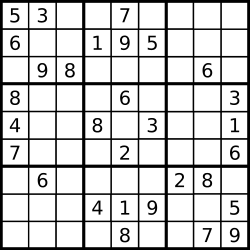Determine if a 9x9 Sudoku board is valid. Only the filled cells need to be validated according to the following rules:
- Each row must contain the digits
1-9without repetition. - Each column must contain the digits
1-9without repetition. - Each of the 9
3x3sub-boxes of the grid must contain the digits1-9without repetition.

The Sudoku board could be partially filled, where empty cells are filled with the character '.'.
Example 1:
Input: [ ["5","3",".",".","7",".",".",".","."], ["6",".",".","1","9","5",".",".","."], [".","9","8",".",".",".",".","6","."], ["8",".",".",".","6",".",".",".","3"], ["4",".",".","8",".","3",".",".","1"], ["7",".",".",".","2",".",".",".","6"], [".","6",".",".",".",".","2","8","."], [".",".",".","4","1","9",".",".","5"], [".",".",".",".","8",".",".","7","9"] ] Output: true
Example 2:
Input:
[
["8","3",".",".","7",".",".",".","."],
["6",".",".","1","9","5",".",".","."],
[".","9","8",".",".",".",".","6","."],
["8",".",".",".","6",".",".",".","3"],
["4",".",".","8",".","3",".",".","1"],
["7",".",".",".","2",".",".",".","6"],
[".","6",".",".",".",".","2","8","."],
[".",".",".","4","1","9",".",".","5"],
[".",".",".",".","8",".",".","7","9"]
]
Output: false
Explanation: Same as Example 1, except with the 5 in the top left corner being
modified to 8. Since there are two 8's in the top left 3x3 sub-box, it is invalid.
Note:
- A Sudoku board (partially filled) could be valid but is not necessarily solvable.
- Only the filled cells need to be validated according to the mentioned rules.
- The given board contain only digits
1-9and the character'.'. - The given board size is always
9x9.
终极之无敌巧妙方法,理解不能
class Solution {
/*
int rowIndex = 3 * (i / 3);
int colIndex = 3 * (i % 3);
i~[0,8]
0 1 2 3 4 5 6 7 8
0 0 0 3 3 3 6 6 6 row Index
0 3 6 0 3 6 0 3 6 colIndex
0 0 0 1 1 1 2 2 2 j / 3
0 1 2 0 1 2 0 1 2 j % 3
扫描cube时是从左到右从上到下扫描9个cube
*/ public boolean isValidSudoku(char[][] board) { for(int i = 0; i < board.length; i++){ HashSet<Character> rows = new HashSet<>(); HashSet<Character> cols = new HashSet<>(); HashSet<Character> cube = new HashSet<>(); for(int j = 0; j < board[0].length; j++){ if(board[i][j] != '.' && !rows.add(board[i][j])) return false; if(board[j][i] != '.' && !cols.add(board[j][i])) return false; int rowIndex = 3 * (i / 3); int colIndex = 3 * (i % 3); if(board[rowIndex + j / 3][colIndex + j % 3] != '.' && !cube.add(board[rowIndex + j / 3][colIndex + j % 3])) return false; } } return true; } }
好的 终于有一种看得懂的方法了,那就是遍历三次,检查三次
class Solution { public boolean isValidSudoku(char[][] board) { //判断每一行 for (int i = 0; i < 9; i++) { if (!isValidRows(board[i])) { return false; } } //判断每一列 for (int i = 0; i < 9; i++) { if (!isValidCols(i, board)) { return false; } } //判断每个小棋盘 for (int i = 0; i < 9; i = i + 3) { for (int j = 0; j < 9; j = j + 3) { if (!isValidSmall(i, j, board)) { return false; } } } return true; } public boolean isValidRows(char[] board) { HashMap<Character, Integer> hashMap = new HashMap<>(); for (char c : board) { if (c != '.') { if (hashMap.getOrDefault(c, 0) != 0) {//用getOrDefault是为了防止得到一个null(还不存在的element) return false; } else { hashMap.put(c, 1); } } } return true; } public boolean isValidCols(int col, char[][] board) { HashMap<Character, Integer> hashMap = new HashMap<>(); for (int i = 0; i < 9; i++) { char c = board[i][col]; if (c != '.') { if (hashMap.getOrDefault(c, 0) != 0) { return false; } else { hashMap.put(c, 1); } } } return true; } public boolean isValidSmall(int row, int col, char[][] board) { HashMap<Character, Integer> hashMap = new HashMap<>(); for (int i = 0; i < 3; i++) { for (int j = 0; j < 3; j++) { char c = board[row + i][col + j]; if (c != '.') { if (hashMap.getOrDefault(c, 0) != 0) { return false; } else { hashMap.put(c, 1); } } } } return true; } }
可不可以只遍历一次呢?可以,牛逼
class Solution { public boolean isValidSudoku(char[][] board) { Set seen = new HashSet(); for (int i=0; i<9; ++i) { for (int j=0; j<9; ++j) { char number = board[i][j]; if (number != '.') if (!seen.add(number + " in row " + i) || !seen.add(number + " in column " + j) || !seen.add(number + " in block " + i/3 + "-" + j/3)) return false; } } return true; } }